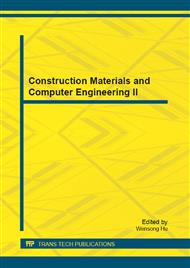[1]
H. Oka, S. Uchidate, N. Sekino, Y. Namizaki, K. Kubota, H. Osada, F.P. Dawson, and J.D. Lavers,: Electromagnetic Wave Absorption Characteristics of Half Carbonized Powder-Type Magnetic Wood, IEEE Transactions on Magnetics, Vol. 47, (2011).
DOI: 10.1109/tmag.2011.2157662
Google Scholar
[2]
C. Li, J. Wang, and J. Zhu,: Experiment and Theoretical Study on Thermal Performance of Honeycomb Ceramic Regenerative Heat Exchanger, Power and Energy Engineering Conference (APPEEC) Asia-Pacific, (2010), pp.1-6.
DOI: 10.1109/appeec.2010.5449404
Google Scholar
[3]
B. Sonerud, T. Bengtsson, J. Blennow and S.M. Gubanski,: Dielectric heating in insulating materials subjected to voltage waveforms with high harmonic content, IEEE Transactions on Dielectrics and Electrical Insulation, Vol. 16, (2009), pp.926-933.
DOI: 10.1109/tdei.2009.5211835
Google Scholar
[4]
Y. Okamoto, R. Himeno, K. Ushida, A. Ahagon and K. Fujiwara,: A Dielectric Heating Analysis Method With Accurate Rotational Motion of Stirrer Fan Using Nonconforming Mesh Connection, IEEE Transactions on Magnetics, Vol. 44, (2008), pp.806-809.
DOI: 10.1109/tcst.2007.916313
Google Scholar
[5]
J. Larry Zettler and F. H. Arthur,: Chemical control of stored product insects with fumigants and residual treatments, Crop Protection Vol. 1, (2000), pp.577-582.
DOI: 10.1016/s0261-2194(00)00075-2
Google Scholar
[6]
P.M. Edward and S. K. Elena,: Aminopeptidase-Like Activity in Hemolymph Plasma from Larvae of the Gypsy Moth, Lymantria dispar (Lepidoptera: Lymantriidae) Comp Biochem Physiol, Vol. 116B, (1997) p.11–18.
DOI: 10.1016/s0305-0491(96)00194-0
Google Scholar
[7]
V. Komarov,: Dielectric and Thermal Properties of Materials at Microwave Frequencies, Handbook, Artech House, (2012).
Google Scholar
[8]
S. Wang, J. Tang, J.A. Johnson, E. Mitcham, J.D. Hansen, G. Hallman, S.R. Drake, and Y. Wang,: Dielectric Properties of Fruits and Insect Pests as related to Radio Frequency and Microwave Treatments, Biosystems Engineering, Vol. 85, (2003).
DOI: 10.1016/s1537-5110(03)00042-4
Google Scholar
[9]
O. Sitophilus and P. G. Koehler,: Rice Weevil, University of Florida, IFAS Extension, Reviseed (2012).
Google Scholar
[10]
Nelson, O. Stuart,: Agricultural applications of dielectric measurements, IEEE Transactions on Dielectrics and Electrical Insulation, Vol. 13, (2006), pp.688-702.
DOI: 10.1109/tdei.2006.1667726
Google Scholar


